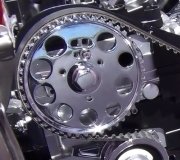You might as well stop right now and do a cylinder leakage test. Eight inches of missing teeth on the belt means you waited way too long to do the maintenance belt replacement. You are definitely going to have bent valves and the cylinder leakage test will show that. You should be able to find the tester at an auto parts store that rents or borrows tools. The clue is your observation of, "it sounded odd, like the engine was spinning way faster than it did before".
Also, if you think about your 180 degree concern, if you have the crankshaft and camshaft sprockets in perfect time, then you rotate the crankshaft one complete revolution, the camshaft is going to be off 180 degrees. Rotate the crankshaft another full turn and the timing will be correct. The cam sprocket has exactly twice as many teeth as does the crankshaft sprocket, so it turns half as much.
The reason Saturntech9 told you to turn the crankshaft backward 90 degrees is to insure no piston is at top dead center. That way there is no chance of a valve hitting the top of a piston while you rotate the camshaft by hand. Now you can bring the crankshaft to top dead center and install the belt. The tensioning device will always be on the backside of the engine, meaning where the belt leaves the crankshaft sprocket. The sprocket is pulling the belt tight on the front. That is the point where timing is critical between the sprockets. Any slack will be taken up on the other side where belt length has nothing to do with keeping things in proper time.
Once everything is installed and in time, rotate the crankshaft forward by hand two complete revolutions, then recheck the timing marks. Never go backward as someone suggested to you. Doing so might not cause a problem, but it is not accepted practice. On some engines that will cause spring-loaded tensioners to retract and allow the belt to jump or the tensioner can be tightened down while putting insufficient tension of the belt. Turning the crankshaft backward pulls the rear section of the belt tight and can cause the tensioner to retract. Also, if the belt doesn't jump time, the crank is going to turn the equivalent of two or three teeth and take up the slack, then the camshaft sprocket will start to turn. That will incorrectly show the belt is installed in what appears to be in-time while it's actually off by those two or three teeth.
Friday, September 16th, 2016 AT 1:09 PM



